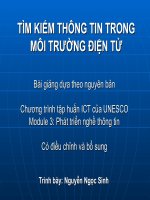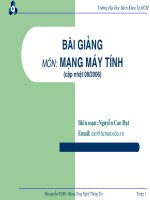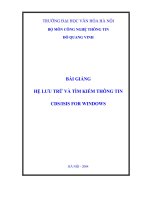Chương 2 Bài giảng môn Tìm kiếm thông tin Trương Quốc Định
Bạn đang xem bản rút gọn của tài liệu. Xem và tải ngay bản đầy đủ của tài liệu tại đây (479.14 KB, 47 trang )
Introduction to Information Retrieval
Introduction to
Information Retrieval
Chap. 2: The term vocabulary and postings lists
Introduction to Information Retrieval
Recap of the previous lecture
Basic inverted indexes:
Structure: Dictionary and Postings
Key step in construction: Sorting
Boolean query processing
Intersection by linear time “merging”
Simple optimizations
Ch. 1
Introduction to Information Retrieval
Plan for this lecture
Elaborate basic indexing
Preprocessing to form the term vocabulary
Documents
Tokenization
What terms do we put in the index?
Postings
Faster merges: skip lists
Positional postings and phrase queries
Introduction to Information Retrieval
Recall the basic indexing pipeline
Documents to
be indexed.
Friends, Romans, countrymen.
Tokenizer
Friends Romans
Token stream.
Countrymen
Linguistic
modules
Modified tokens.
Inverted index.
friend
roman
countryman
Indexer friend
2
4
roman
1
2
countryman
13
16
Introduction to Information Retrieval
Sec. 2.1
Parsing a document
What format is it in?
pdf/word/excel/html?
What language is it in?
What character set is in use?
Each of these is a classification problem, which we
will study later in the course.
But these tasks are often done heuristically …
Introduction to Information Retrieval
Sec. 2.1
Complications: Format/language
Documents being indexed can be written in many different languages
A single index may have to contain terms of
several languages.
Sometimes a document or its components can contain multiple
languages/formats
French email with a German pdf attachment.
What is a unit document?
A file?
An email? (Perhaps one of many in an mbox.)
An email with 5 attachments?
A group of files (PPT or LaTeX as HTML pages)
Introduction to Information Retrieval
TOKENS AND TERMS
Sec. 2.2.1
Introduction to Information Retrieval
Tokenization
Input: “Friends, Romans and Countrymen”
Output: Tokens
Friends
Romans
Countrymen
Input: “Quản lý chuỗi khách sạn của một doanh nghiệp”
Output: Tokens
Quản_lý chuỗi
khách_sạn
một doanh_nghiệp
của
A token is an instance of a sequence of characters
Each such token is now a candidate for an index entry, after further
processing
But what are valid tokens to emit?
Introduction to Information Retrieval
Sec. 2.2.1
Tokenization
Issues in tokenization:
Finland’s capital →
Finland? Finlands? Finland’s?
Hewlett-Packard → Hewlett and Packard as two
tokens?
state-of-the-art: break up hyphenated sequence.
co-education
lowercase, lower-case, lower case ?
It can be effective to get the user to put in possible hyphens
San Francisco: one token or two?
How do you decide it is one token?
Sec. 2.2.1
Introduction to Information Retrieval
Numbers
3/20/91
Mar. 20, 1991
55 B.C.
B-52
My PGP key is 324a3df234cb23e
(800) 234-2333
20/3/91
Often have embedded spaces
Older IR systems may not index numbers
But often very useful: think about things like looking up error
codes/stacktraces on the web
Will often index “meta-data” separately
Creation date, format, etc.
Introduction to Information Retrieval
Sec. 2.2.1
Tokenization: language issues
French
L'ensemble → one token or two?
L ? L’ ? Le ?
Want l’ensemble to match with un ensemble
Until at least 2003, it didn’t on Google
Internationalization!
German noun compounds are not segmented
Lebensversicherungsgesellschaftsangestellter
‘life insurance company employee’
German retrieval systems benefit greatly from a compound splitter
module
Can give a 15% performance boost for German
Sec. 2.2.1
Introduction to Information Retrieval
Tokenization: language issues
Chinese and Japanese have no spaces between words:
莎莎莎莎莎莎莎莎莎莎莎莎莎莎莎莎莎莎莎莎
Not always guaranteed a unique tokenization
Further complicated in Japanese, with multiple alphabets
intermingled
Dates/amounts in multiple formats
莎莎莎莎莎莎 500 莎莎莎莎莎莎莎莎莎莎莎莎莎 $500K( 莎 6,000 莎莎 )
Katakana Hiragana
Kanji
Romaji
End-user can express query entirely in hiragana!
Sec. 2.2.1
Introduction to Information Retrieval
Tokenization: language issues
Arabic (or Hebrew) is basically written right to left, but with certain items
like numbers written left to right
Words are separated, but letter forms within a word form complex
ligatures
← → ←→
← start
‘Algeria achieved its independence in 1962 after 132 years of French
occupation.’
Introduction to Information Retrieval
Sec. 2.2.2
Stop words
With a stop list, you exclude from the dictionary entirely the
commonest words. Intuition:
They have little semantic content: the, a, and, to, be
There are a lot of them: ~30% of postings for top 30 words
But the trend is away from doing this:
Good compression techniques (Ch. 5) means the space for
including stopwords in a system is very small
Good query optimization techniques (Ch. 7) mean you pay little at
query time for including stop words.
You need them for:
Phrase queries: “King of Denmark”
Various song titles, etc.: “Let it be”, “To be or not to be”
“Relational” queries: “flights to London”
Introduction to Information Retrieval
Sec. 2.2.3
Normalization to terms
We need to “normalize” words in indexed text as well as query words
into the same form
We want to match U.S.A. and USA
Result is terms: a term is a (normalized) word type, which is an entry in
our IR system dictionary
We most commonly implicitly define equivalence classes of terms by,
e.g.,
deleting periods to form a term
U.S.A., USA USA
deleting hyphens to form a term
anti-discriminatory, antidiscriminatory antidiscriminatory
Introduction to Information Retrieval
Sec. 2.2.3
Normalization: other languages
Accents: e.g., French résumé vs. resume.
Umlauts: e.g., German: Tuebingen vs. Tübingen
Should be equivalent
Most important criterion:
How are your users like to write their queries for
these words?
Even in languages that standardly have accents, users often may not
type them
Often best to normalize to a de-accented term
Tuebingen, Tübingen, Tubingen Tubingen
Introduction to Information Retrieval
Sec. 2.2.3
Normalization: other languages
Normalization of things like date forms
7 莎 30 莎 vs. 7/30
Japanese use of kana vs. Chinese
characters
Tokenization and normalization may depend on the language and so is
intertwined with language detection
Is this
Morgen will ich in MIT … German “mit”?
Crucial: Need to “normalize” indexed text as well as query terms into the
same form
Introduction to Information Retrieval
Case folding
Reduce all letters to lower case
exception: upper case in mid-sentence?
e.g., General Motors
Fed vs. fed
SAIL vs. sail
Often best to lower case everything,
since users will use lowercase
regardless of ‘correct’ capitalization…
Google example:
Query C.A.T.
#1 result is for “cat” (well, Lolcats) not
Caterpillar Inc.
Sec. 2.2.3
Introduction to Information Retrieval
Sec. 2.2.3
Normalization to terms
An alternative to equivalence classing is to do asymmetric expansion
An example of where this may be useful
Enter: window
Search: window, windows
Enter: windows Search: Windows, windows, window
Enter: Windows Search: Windows
Potentially more powerful, but less efficient
Introduction to Information Retrieval
Thesauri and soundex
Do we handle synonyms and homonyms?
E.g., by hand-constructed equivalence classes
car = automobile
color = colour
We can rewrite to form equivalence-class terms
When the document contains automobile, index it under carautomobile (and vice-versa)
Or we can expand a query
When the query contains automobile, look under car as well
What about spelling mistakes?
One approach is soundex, which forms
equivalence classes of words based on phonetic
heuristics
Introduction to Information Retrieval
Sec. 2.2.4
Lemmatization
Reduce inflectional/variant forms to base form
E.g.,
am, are, is → be
car, cars, car's, cars' → car
the boy's cars are different colors → the boy car be different color
Lemmatization implies doing “proper” reduction to dictionary headword
form
Sec. 2.2.4
Introduction to Information Retrieval
Stemming
Reduce terms to their “roots” before indexing
“Stemming” suggest crude affix chopping
language dependent
e.g., automate(s), automatic, automation all
reduced to automat.
for example compressed
and compression are both
accepted as equivalent to
compress.
for exampl compress and
compress ar both accept
as equival to compress
Introduction to Information Retrieval
Sec. 2.2.4
Porter’s algorithm
Commonest algorithm for stemming English
Results suggest it’s at least as good as other
stemming options
Conventions + 5 phases of reductions
phases applied sequentially
each phase consists of a set of commands
sample convention: Of the rules in a compound
command, select the one that applies to the
longest suffix.
Introduction to Information Retrieval
Typical rules in Porter
sses → ss
ies → i
ational → ate
tional → tion
Weight of word sensitive rules
(m>1) EMENT →
replacement → replac
cement → cement
Sec. 2.2.4
Introduction to Information Retrieval
Sec. 2.2.4
Other stemmers
Other stemmers exist, e.g., Lovins stemmer
/>
Single-pass, longest suffix removal (about 250
rules)
Full morphological analysis – at most modest benefits for retrieval
Do stemming and other normalizations help?
English: very mixed results. Helps recall for some queries but
harms precision on others
E.g., operative (dentistry) ⇒ oper
Definitely useful for Spanish, German,
Finnish, …
30% performance gains for Finnish!









